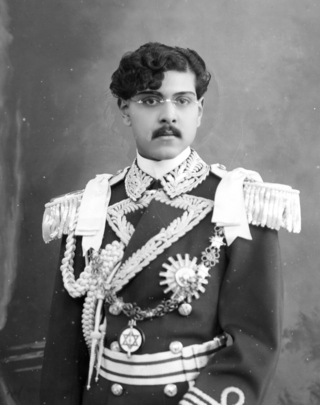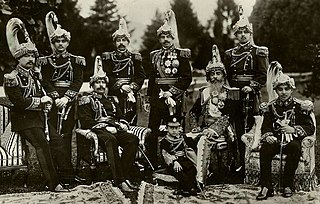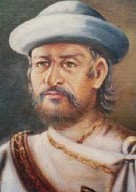
The Kingdom of Nepal was a Hindu kingdom in South Asia, formed in 1768 by the expansion of the Gorkha Kingdom, which lasted until 2008 when the kingdom became the Federal Democratic Republic of Nepal. It was also known as the Gorkha Empire, or sometimes Asal Hindustan. Founded by King Prithvi Narayan Shah, a Gorkha monarch who claimed to be of Thakuri origin from chaubisi, it existed for 240 years until the abolition of the Nepalese monarchy in 2008. During this period, Nepal was formally under the rule of the Shah dynasty, which exercised varying degrees of power during the kingdom's existence.

Tribhuvan Bir Bikram Shah Dev, was King of Nepal. Born in Kathmandu, the capital city of Nepal, he ascended to the throne at the age of five, upon the death of his father, Prithvi Bir Bikram Shah, and was crowned on 20 February 1913 at the Nasal Chowk, Hanuman Dhoka Palace in Kathmandu, with his mother acting as regent. At the time of his crowning, the position of monarch was largely ceremonial, with the real governing power residing with the Rana family.

The prime minister of Nepal is the head of government of Nepal. Together with their Council of ministers, The prime minister exercises executive power in the country. The prime minister must enjoy the confidence in the Pratinidhi Sabha before being appointed by the president and shall resign if they are unable to retain the majority in the House.

The Rana dynasty was a Chhetri dynasty that imposed authoritarianism in the Kingdom of Nepal from 1846 until 1951, reducing the Shah monarch to a figurehead and making the Prime Minister and other government positions held by the Ranas hereditary. The Rana dynasty is historically known for their iron-fisted rule in Nepal. This changed after the Revolution of 1951 with the promulgation of a new constitution, when power shifted back to the monarchy of King Tribhuvan.

Basnyat/Basnet family or Basnyat/Basnet dynasty was a Khas-Chhetri and a warlord clan family involved in the politics and administration of the Gorkha Kingdom and Kingdom of Nepal. This family got entry into Thar Ghar aristocracy group of Gorkha at the time of King Prithvi Narayan Shah. It was one of the four noble families to be involved in active politics of Nepal together with the Shah dynasty, Pande family and the Thapa dynasty before the rise of the Rana dynasty. This family is descended from Shivaram Singh Basnyat, the commander of Gorkhali forces and a member of Shreepali Basnyat clan of Gorkha. This family was maritally linked to Kala (Black) Pande section of the Pande dynasty through Chitravati Pande who married Kaji Kehar Singh Basnyat. This family was the last Kshatriya (Chhetri) political family to be wiped out from the central power by Jung Bahadur Rana of Kunwar family during the Bhandarkhal Massacre in 1846 for the conspiracy to take the power leading to people suffering from 104 long years of the Rana rule.

The Government of Nepal is the federal executive authority of Nepal. Prior to the abolition of the Nepalese monarchy in 2006, it was officially known as His Majesty's Government.

Damodar Pande was the Mulkaji of Nepal from 1803 until March 1804 and the most influential Kaji from 1794 to his execution on March 13, 1804. He is also arguably referred to as the first Prime Minister of Nepal. He was the youngest son of famous Kaji of Prithivi Narayan Shah Kalu Pande. He was born in 1752 in Gorkha. Damodar Pande was one of the commanders during the Sino-Nepalese War and in Nepal-Tibet War. He was among the successful Gorkhali warriors sent towards the east by Prithivinarayan Shah.

Kaji was a title and position used by nobility of Gorkha Kingdom (1559–1768) and Kingdom of Nepal between 1768 and 1846. Many other contemporary kingdoms used the same title for their ministers.

Bal Narsingh Kunwar or Balanarsingh Kanwar posthumously referred as Bal Narsingh Kunwar Rana was a Kaji, military officer and governor in the Kingdom of Nepal.

Rana Jang Pande was the 3rd Prime Minister of the government of Nepal and the most powerful person in political scenario in three decades from the aristocratic Pande clan. He was one of the sons of Mukhtiyar Kaji Damodar Pande. He served as the Prime Minister for two terms, serving 1837–1837 and 1839–1840 AD. He became powerful after Bhimsen Thapa was arrested, and was declared Mukhtiyar and Commander in Chief. He was a grandson of Kaji Kalu Pandey who was the commander of King Prithvi Narayan Shah and the Mulkaji of Gorkha and a notable figure during the unification campaign of Nepal.
Bir Bhadra Thapa or Birabhadra Thapa also spelled Virabhadra or Virbhadra, was a politician, courtier and military officer in the Gorkha Kingdom during the 18th century. Born in the medieval Tanahun Kingdom, he left his ancestral property there and migrated to the uprising Gorkha Kingdom. He got entry into the minor ranks of military of King Prithvi Narayan Shah due to being a nephew of Sura Prabha, the wife of military commander Shivaram Singh Basnyat of the Basnyat dynasty. Thereafter, he took part in the various battles of Unification of Nepal throughout his life. Among his grandsons, Bhimsen Thapa went on to become the Mukhtiyar of Nepal for 31 years and founder of Thapa dynasty.
Amar Singh Thapa, distinguished as Sanukaji Amar Singh Thapa was a Nepalese military commander, courtier, minister and regional administrator. He was born as the youngest son of one of the leading Gorkhali Bharadar Birabhadra Thapa. He led battles against many independent principalities in Nepal and a battle against Tibet. He was a Governor of Palpa and retained the post till his death in 1814.
Ranajit Pande was a Nepalese politician, military personnel and courtier in the Kingdom of Nepal. He was a member of the Gora Pande clan of Gorkha. He became Mulkaji of Nepal for a brief period in 1804 A.D.

The Pande family or Pande dynasty was a Chhetri political family with ancestral roots from Gorkha Kingdom that directly ruled Nepali administration affairs from the 16th century to 19th century as Mulkaji and Mukhtiyar. This dynasty/family was one of the four noble families to be involved in active politics of Nepal together with the Shah dynasty, Basnyat family and Thapa dynasty before the rise of the Rana dynasty. The Pande dynasty is the oldest noble family to hold the title of Kaji. This family was decimated from political power in 1843 CE in the political massacre by Prime Minister Mathabar Singh Thapa as a revenge for his uncle Bhimsen's death in 1839.
Dalbhanjan Pande or Dalabhanjan Pande was a Nepalese minister, politician and military officer of the aristocratic Pande family. He had held ministerial positions and military offices. He jointly headed the military administration of Nepal in 1837 along with Mukhtiyar Rana Jang Pande.

Mulkaji was the position of head of executive of Kingdom of Nepal in the late 18th and early 19th centuries. It was equivalent to Prime Minister of Nepal. There were 5 Mulkajis appointed between 1785 and 1804.
The Kunwar family was a noble Khas-Chhetri family in the Gorkha Kingdom and the Kingdom of Nepal. The Kunwars were linked to the Thapa dynasty and family of Amar Singh Thapa by marital lineages and, thus, to Pande dynasty through the Thapa dynasty. Three branches of the Kunwars; Ramakrishna, Jayakrishna and Amar Singh Kunwar were formed with opposite political aspirations. Bal Narsingh Kunwar supported Mukhtiyar Bhimsen Thapa while Chandrabir Kunwar supported Bada Kaji Amar Singh Thapa due to their marital relations with those families. Later, the Ramakrishna section of the family including Amarsingh established the Rana dynasty of Nepal and styled themselves as Rana Rajputs while Jayakrishna most section remained as Kunwars.
The Chief of the Nepalese Army is the military position of army head of the Nepalese Army, initially known as Gorkhali Army. The Chief of the Nepalese Army had been from among the Kaji officers during the 18th century. During the reign of Bhimsen Thapa, the title of Commander-in-Chief was introduced for the first time for denoting the army chief. Later in the late 1970s, the title was changed to Chief of Army Staff (CoAS). Currently, the Chief of Army Staff is the Chief of the Nepalese Army.Gurung Magar Thakuri were thakurai/chatrapal/thakurs /kings of western Nepal.Some of chief army head of Nepal is missing.

Dhir Shumsher Kunwar, after 1848 known as Dhir Shumsher Kunwar Ranaji or Dhir Shumsher Jang Kunwar Ranaji or shortly Dhir Shumsher Rana posthumously known as Dhir Shumsher Jang Bahadur Rana, was a Nepalese politician, army general, and minister of state. He served as the Commander-In-Chief of the Nepalese Army from 1879 to 1884.














